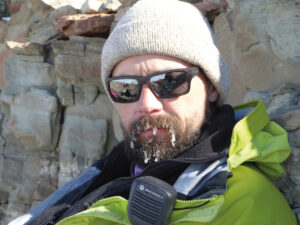Christian Sidor ’94
 DEGREES: B.S. in biology; M.S. and Ph.D. in organismal biology and anatomy, University of Chicago
DEGREES: B.S. in biology; M.S. and Ph.D. in organismal biology and anatomy, University of Chicago
JOB TITLE: Professor of biology, University of Washington; curator of vertebrate paleontology and associate director of research and collections, UW Burke Museum
FAVORITE TRINTY MEMORY: While at Trinity, I played bass in a band—Red House—with some of my roommates. It was a great experience, and we’ve stayed in touch ever since, although I sold all of my music equipment long ago.
What was your path to your current position? Right after grad school, I was a postdoctoral fellow at the Smithsonian’s National Museum of Natural History for about eight months but then left to start a professorship teaching medical school anatomy on Long Island, which I did for four years. I arrived at the University of Washington in Seattle in 2005—20 years ago, which is shocking to consider.
What do you do in your role? Most people don’t realize this, but being a curator at a natural history museum is primarily a research position. I assist with exhibit development and other public programs when my expertise is needed, but most of my time is spent writing papers, applying for grants, and advising graduate students. In addition, in my role as a biology professor, I teach one undergraduate course a year (usually “Comparative Vertebrate Anatomy” or “Vertebrate Paleontology”) and graduate seminars.
What do you enjoy most about your work?
At the broadest scale, I like that my chosen discipline—vertebrate paleontology—is an academic pursuit that resonates with the general public. Whenever someone finds out that I work on fossils for a living, they always have a question or wonder what I thought of the latest story they saw online.
What is the primary focus of your research?
I study the fossils of the animals that lived on land during the Permian and Triassic periods, concentrating on those from about 260 to 220 million years ago. I’m interested in the geographic distribution of these animals before and after the end-Permian mass extinction, which was the single largest loss of life in earth history. In addition, I am particularly interested in the lineage that eventually gave rise to mammals, which diverged from the reptilian lineage about 320 million years ago. Most people don’t know this, but the first mammals and the first dinosaurs appeared at about the same time during the Late Triassic.
What have been some of your favorite locations to do research?
I’ve led fieldwork projects in lots of interesting places—Antarctica, Niger, Tanzania, and Zambia, among others. This is primarily because each of those host the appropriate types of rocks that preserve the fossils I’m interested in studying. In addition, many of these don’t have the long history of fossil collecting like Montana or Wyoming, meaning that the chance of discovering something new is relatively good.
How did Trinity prepare you for your career?
The single biggest thing that Trinity did was provide the opportunity to do research that led to a peer-reviewed publication while I was still an undergraduate. I don’t think I would have ever gotten into grad school without that experience, which came from being able to work with a professor for nearly two years on a project (e.g., from collecting and analyzing the data to making figures and writing drafts of the manuscript).
What was the most memorable course you took at Trinity?
Dan Blackburn’s “Vertebrate Zoology” was my favorite course, which is no surprise since I teach something similar today. Understanding how animals as different as sharks and cats share the same fundamental organization was something I first got to learn about and appreciate at Trinity, and I enjoy being able to pass that along to my students.
Was there a professor at Trinity who was particularly influential?
This is easy—Dan Blackburn. He was my adviser in the Biology Department, and I did research in his lab for two years. With Dan’s help, I presented research at my first professional biology meeting. We eventually co-authored two papers on this project, and about 10 years ago, we reconnected and published another paper, this time tapping into my knowledge of the vertebrate fossil record. Dan’s mentorship was critical for my decision to go to graduate school and to pursue an academic career.
What advice would you give to students who are interested in pursuing a career similar to yours?
Getting into graduate school is increasingly competitive. To get a leg up, I strongly recommend doing research as an undergraduate and, ideally, publishing it in a peer-reviewed journal or presenting it at a conference.
